
|
||
|
Portland art blog + news + exhibition reviews + galleries + contemporary northwest art
|
||
The Rodin experience at PAM 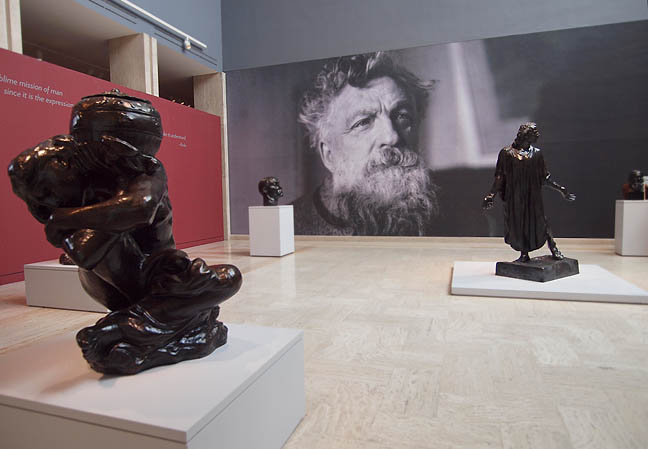 One of The Burghers of Calais, Jean de Fiennes, Clothed (center right) by Laurel Reed Pavic An enormous headshot of Auguste Rodin greets visitors to the Portland Art Museum's Rodin: The Human Experience. His face is wall-sized, bearded, with crinkly, twinkly eyes; it is everything we want to see in our artistic geniuses. The show is part of a celebration of the sculptor's work 100 years after his death in 1917. The sculptures are all from the Iris and Gerald B. Cantor Collections and part of Portland Art Museum's drive to "bring the world to Oregon" in the words of Director and now Chief Curator Brian Ferriso. The works in the exhibition are a fascinating smattering from Rodin's extensive oeuvre. The exhibition begins in the atrium with four studies or reprisals for Rodin's "breakout" commission for The Burghers of Calais (1884-1895) and two Caryatids. A cast of Jean de Fiennes, Clothed anchors the atrium grouping and provides an opportunity for a wall tag to introduce Rodin's famous public monument. The Monumental Head of Jean d'Aire to the left is also inspired by The Burghers though the head wasn't modeled until more than a decade after the completion of the monument (1908-1909). Both the Jean de Fiennes and the Jean d'Aire are situated so that when the viewer encounters the sculpted profiles, they are visually echoed by Rodin's looming photograph. The sculptor becomes the sculpture. 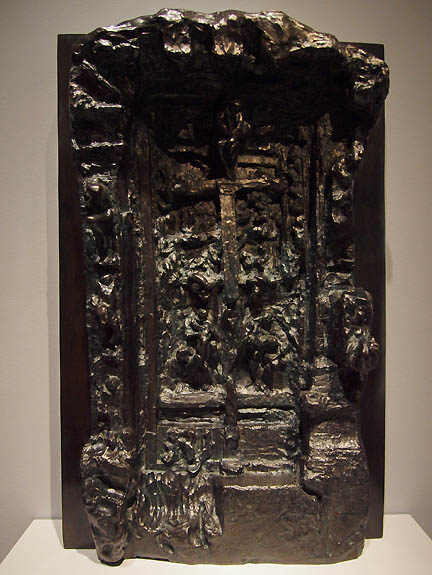 Study for The Gates of Hell The show continues thematically with sculptures that showcase Rodin's mastery of the human form in movement and human expression in portraiture. The presentation is traditional with dark gray walls and carefully placed lighting that makes the most of the mottled surfaces and patina of the bronze. The Cantor Foundation should be commended for its commitment to making the works of Rodin accessible to the public. Rodin was a committed to art for the public and about humanity at large. Two of his best known projects, the Burghers of Calais and the unfinished Gates of Hell, were for public spaces and meant to be seen by all. Rodin didn't limit his works or their appeal to a rarified, upper-crust crowd. He gave his oeuvre to the French State to make a public museum precisely to continue this democratizing project, to show that art can speak to and for all instead of just to the elite. 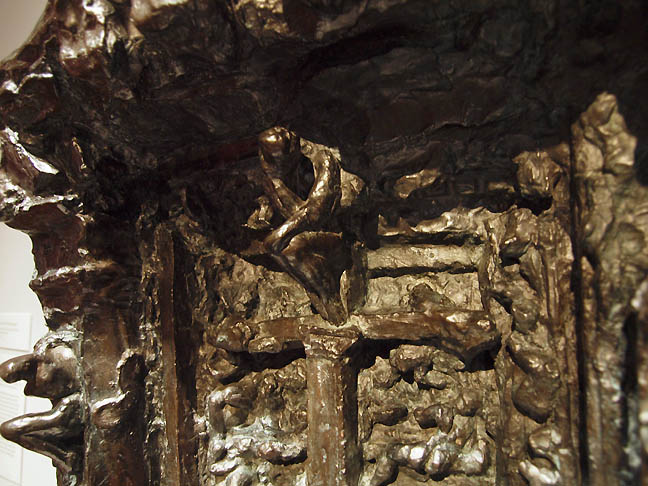 Detail of The Gates of Hell (study), note The Thinker (center) This larger humanistic project is less evident than it should be though. Consider the atrium homage to The Burghers of Calais centered on Jean de Fiennes. Rodin's full composition of the The Burghers of Calais consists of six individual, independent figures. It wasn't about a single hero but about six ordinary citizens who sacrificed themselves to appease an irrational despot and save their fellow townspeople from starvation. The impact of the monument comes from the collection of individuals bound together only by what they have agreed to do for the good of all. It is about grace in defeat but even more so about collective civic responsibility of everyone, not just those in power. 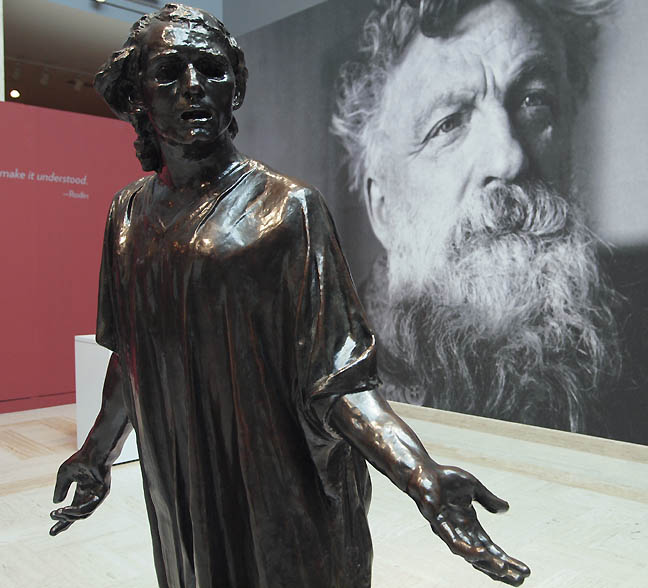 Jean de Fiennes, Clothed There is no denying that Rodin is a seminal figure in the history of art. The sculptures should be seen, contemplated, and admired. However, the headshot, the presentation that encourages hushed tones and adulation of the artist as a singular genius - this isn't what is most deserving of our consideration. Rodin might have died 100 years ago but the sculptures from the Cantor Collection are considerably younger. The majority of the bronzes were cast in the 1980s so they're not even "middle-aged". There is nothing untoward about the age of the sculptures and the show makes no secret of their newness in the exhibition itself. Though cast after Rodin's death, they are all originals because they have been deemed as such by the Musee Rodin. Rodin donated the contents of his studio to the French State before his death. In a series of laws enacted over the course of the 20th Century, the French State limited production to twelve casts so as to ensure the value of the Rodin casts. These are original works. 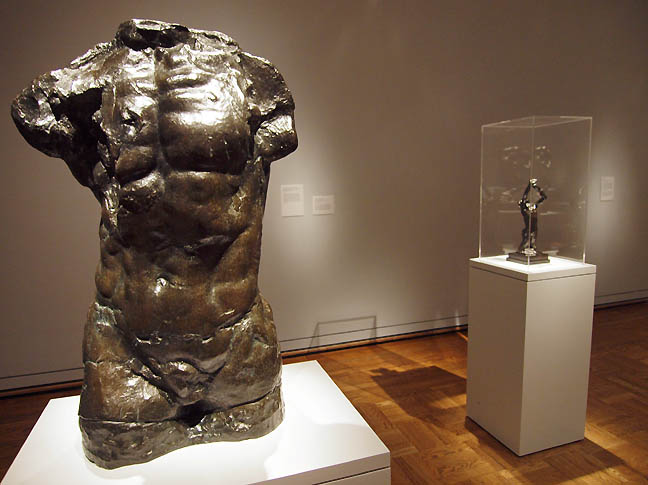
However, these original works required more artistry and craft than what was bestowed by Rodin's own hand to come to fruition. The museum labels explain how Rodin made his sculptures out of clay or wax and then left it to studio assistants to translate his sculptures into plasters that were then made into bronze castings or marbles. There is a statement about Rodin's large studio and the fact that the foundry supervision was done by assistants. But these are sentences on wall plaques. Their impact is blunted by Rodin's huge face at the entrance. Let's be clear: Rodin himself never touched any of the works in this exhibition. There is only one sculpture, the Metamorphoses of Ovid, that was even possibly cast (its date is unknown) while Rodin was alive. The Musee Rodin doesn't seem to have standardized their approach to the signatures until sometime in the mid-1980s. The signature on the Balzac in Dominican Robes actually has the indication "Musee Rodin 1981" incised onto the surface, which seems more appropriate than the large "A Rodin" on most of the other works. Rodin's fabulous beard hairs never grazed the sculpted surfaces. He may not have even laid his twinkly eyes on many of the works in their bronze state and certainly didn't intend for some to be cast as such (Dance Movement D). In the Oregonian article "12 things to know about the Portland Art Museum's Auguste Rodin exhibit", the director of the Cantor Collections with whom Ferriso organized the show, Judith Sobol, notes that Rodin was "the Jeff Koons of his day or.... the Andy Warhol, he was into fame". I would add to this characterization the further similarity that both Koons and Warhol rely on others to produce their works but the fame aspect is key. Rodin knew his fame depended on the wide distribution of his sculptures. During his lifetime, he allowed 300 castings of his famous sculpture The Kiss. The Monumental Head of Jean d'Aire in the atrium from The Burghers of Calais group was modeled in 1908-1909, fifteen years after the completion of the public commission because there was a demand for variations on the monument. Many sculptures were enlarged or reduced in size to appeal to different patrons. The exhibition includes the Monumental Head of Jean d'Aire and the Saint John the Baptist Preaching that were available to patrons in multiple sizes. In the late 19th and early 20th centuries, size was changed using a plotting device that allowed studio assistants to mechanically trace the surface of one clay or plaster object and have it translate the elevation points to a second object in clay. There is no way around the fact that this was mechanical reproduction executed by studio assistants. 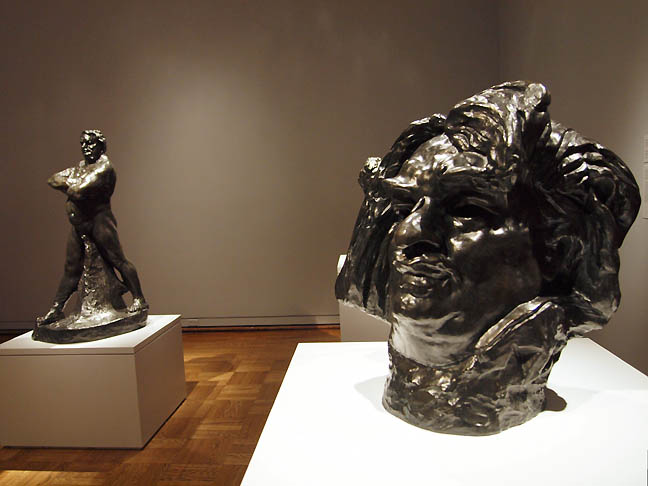 various sculptures of Balzac This mechanical backstory to Rodin's production is why I was thrilled when I saw that the exhibition would include a nod to contemporary technology with 3D printed models of some of Rodin's works. What an opportunity to consider the capabilities of 3D printing and the future of art! If the surface of a Rodin plaster is scanned, turned into a 3D file and printed, how does that differ from the plotted enlargements or reductions executed by Rodin's studio and created after his death? Of course the Musee Rodin won't deem these "originals" and they won't have the same monetary or exhibition value as the works in the Cantor collection but the process and promise they represent is worth our serious consideration. 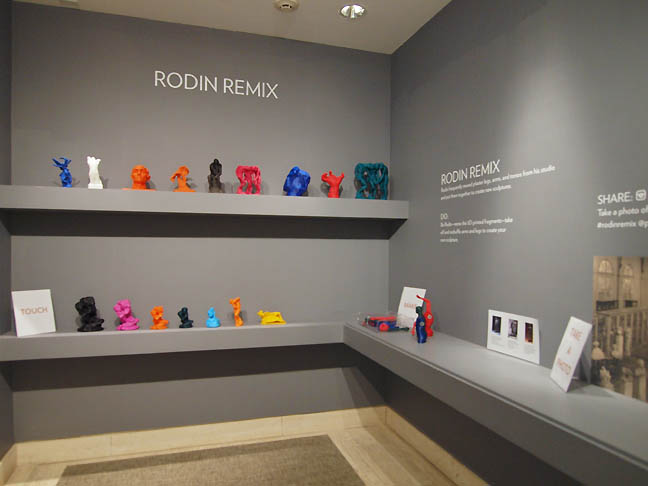 3D printings of Rodin sculptures at PAM I admit that my enthusiasm for the line of inquiry about the reproductive process in Rodin's studio and its contemporary implications may have made my disappointment in the 3D sculptures more acute. When I went to the exhibition, I couldn't even find them at first. They're located in the awkward space to the left of the atrium through the doors. The sculptures are tiny and in garish colors. Instead of a serious conversation about mechanical and technological reproduction, the 3D elements are part of a gimmick; a 'hands-on' lure. They miss an important opportunity. The wall tags invite you to "Be Rodin-remix the 3D printed fragments-take off an reshuffle arms and legs to create your own sculpture". The reuse of sculpted elements is indeed interesting, though to be persnickety in recombining these elements, you're acting more as a studio assistant than Rodin himself (I understand that "Be Rodin's Assistant" is less appealing than "Be Rodin"). Ultimately though, the printed sculptures are pale imitations made on home 3D printers and bear no real likeness to the works in plaster or bronze. The 3D sculptures are for Instagramming rather than for any consideration of the nature of compound media or the role of technology in art production and appreciation. There are fascinating stories to tell with Rodin about collaboration, about fame, about production, about memory and public art. There are conversations to be had about reproduction, about the art market, about technology, about the future of "ownership" in a world in which 3D printing will allow different access to art and require new definitions of words like edition and original. The conversation about Rodin as a genius though -- that conversation has been had. Acknowledging all the hands that are involved in the creation, preservation, display, appreciation, and support of art would benefit us all. Of course the true "human experience" involves emotion and "extreme psychological states" but it also involves collaboration: sometimes it involves working for someone who gets credit for your hard work. The "human experience" requires us to engage with technology and consider why and how creative productions are valued. Rodin wanted to make sculpture democratic; he didn't want it to be solely the domain of those in power. Portland is committed to "open source", to collaboration, to the availability of art for all. Why do we have an exhibition about an artist who spoke to all of these principles we hold so dear more than a century ago that doesn't acknowledge these common values? 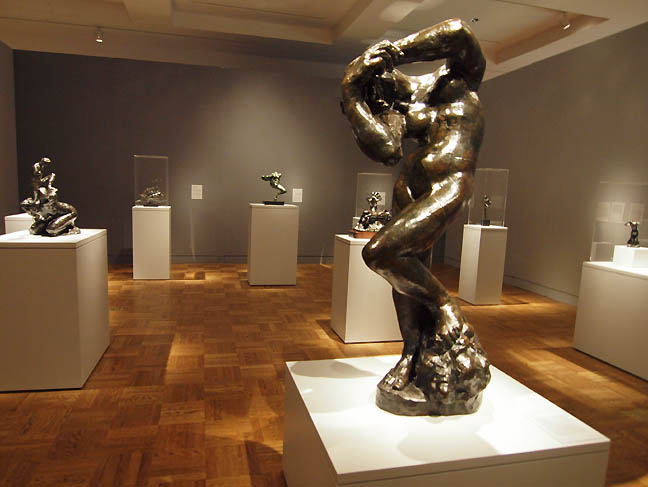
Go to the exhibit and see the sculptures. Take advantage of the Cantor Foundation's commitment to sharing the work of Rodin's studio and the Portland Art Museum's commitment to bringing the world to Oregon. Both are to be appreciated and enjoyed. But don't be swayed by the huge face. Rodin: The Human Experience at The Portland Art Museum Through April 16, 2017 Posted by Guest on April 09, 2017 at 11:02 | Comments (1) Comments Thanks Laurel, It opens up a lot of questions. Certainly mechanically reproduced artworks like photographs, prints and sculpture involve a lot more than the artist to produce and editions can come out posthumously. That really isnt a problem here... like it was with Judd and Count Panza but it does set the stage for the beatification of the beard! The bigger issue is the way museums in general have had a very hard time getting away from beatification of artists, hagiography and a general kind of blockbuster showmanship. This becomes all the more important with the Rothko Pavilion to be constructed at PAM. Rothko and Judd are probably the two most demanding artists out there (even posthumously). Somehow the rest of Portland is just more sensitive to both technology and its role in art production than standard museum practices tend to be... the Laika show might help PAM some but they are a movie production studio and not Rothko. Portland respects geek-craft and I believe that is what feels underrepresented in the Rodin show. It could have been a chance to geek out more on Rodin but instead it feels like... a museum exhibition. It is a museum after all but somehow museums need to evolve. Not as entertainment but as avenues to deepen the experience. It just felt like oversteer and it is ironic because Dawson Carr is easily the most knowledgeable curator at PAM (which is why I like him... these days when I talk to museum curators I often know more than they do about what they are presenting... in the case of Dawson I always learn something, because he really does have mastery of his field of knowledge). I wish that came out more than the beard. It is still a very interesting show and quite good in its not fully-realized way, by virtue of the work itself. Perhaps it just illuminates the divide that PAM has with its most informed audiences? By trying to do what they think they "should" be doing they come off like that over-earnest uncle who heard you are an artist and wants to share/compare their experiences with a Chihuly. There is a crisis of presentation at museums and PAM is hardly the only one... LACMA currently has some terrible installs for example. We all want museums to be accessible but at a certain point access can blunt appreciation. Besides Portland has no shortage of extravagant facial hair, is more needed? The bar has risen in Portland but most of our institutions still do a poor job of installing shows... but that said this is not one of them. It is installed decently with perhaps too much beard porn in a way that will irk only the most serious of visitors. That's a different kind of problem. Museums used to be where the staff were simply the most knowledgeable interlocutors (call them curators). They shared their geek love. That quality has been waning of late with a new wave of curators acting more like 2nd year associate lawyers on constant defense. Perhaps that cant be fixed. Message = leave room for the the geek experience and scholarship rather than bait ploys, dont over-manage the audience. Frankly, I did not want to overstate the beard... but every single art geek I've spoken with who has seen the show has brought this issue up. I tuned it out and enjoyed the show regardless. Posted by: Double J Post a comment Thanks for signing in, . Now you can comment. (sign out)
(If you haven't left a comment here before, you may need to be approved by
the site owner before your comment will appear. Until then, it won't appear
on the entry. Thanks for waiting.)
|
| s p o n s o r s |
 |
 |
 |
 |
 |
 |
 |
 |
 |
 |
 |
 |
 |
 |

|
Site Design: Jennifer Armbrust | • | Site Development: Philippe Blanc & Katherine Bovee | |


![[TypeKey Profile Page]](http://www.portlandart.net/nav-commenters.gif)